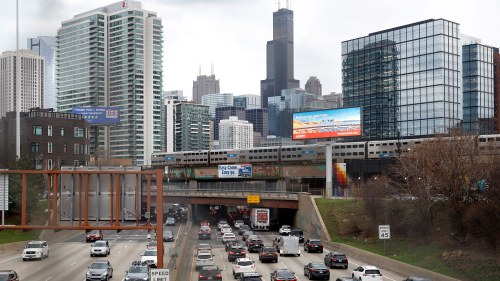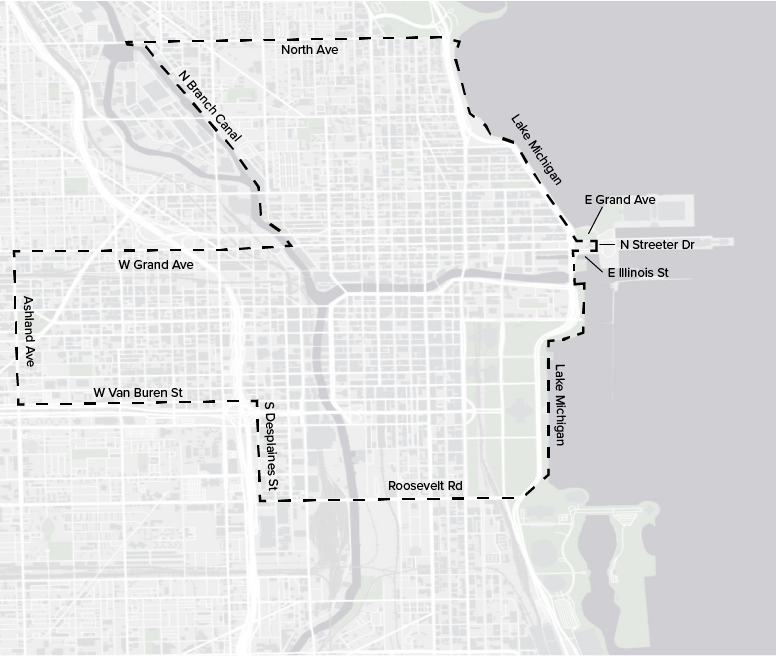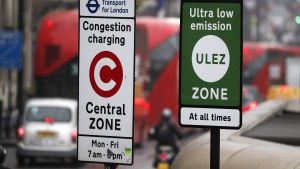Cities around the world charge to drive in certain downtown areas. Could Chicago follow?

Hailed as a way to reduce traffic and pollution and to improve city transit systems, cordon pricing exists in several cities around the world. Could it work in Chicago?
New York City is poised to become the first city in the U.S. to implement a cordon congested pricing plan, something London, Stockholm, Singapore, and other global cities have had in place for years. But could it work in Chicago, the third-largest city in the U.S. and the second-most-congested city in the world?
Congested pricing programs are intended to ease traffic, reduce harmful vehicle emissions, encourage sustainable modes of transportation, and generate funding for public transit systems. They use market forces to charge fees for driving on certain roadways during peak hours. Cordon pricing specifically requires drivers to pay a fee to enter a designated section or zone within a city.
Some form of congested pricing has existed in the U.S. since 1995, when the 91 Express Lanes opened in Orange County, California, but cordon pricing has yet to take off, though the Big Apple is well on its way. If the plan is approved, most drivers can expect to pay $15 to access some of Midtown’s and Lower Manhattan’s busiest streets during daytime hours. New York expects to generate $1 billion in annual revenue for the Metropolitan Transportation Authority through the program.
Subscribe to ChicagoGlobal
This story first appeared in the ChicagoGlobal newsletter, a joint project of Crain's Chicago Business and the Chicago Council on Global Affairs.
Congested pricing in Chicago
In 2022, Chicago drivers spent more hours on average stuck in traffic than drivers in any other U.S. city (155, to be exact), according to a report by INRIX. Globally, only drivers in London had it worse — by an hour.
“Anybody who travels in the central business district at any point, during weekdays particularly, knows that the downtown area is becoming damn near impassable,” said former Mayor Lori Lightfoot during a 2019 interview with the Chicago Tribune. “We don’t have a rush hour. We have a rush day.”
Chicago's uptick in traffic congestion is partly due to the growth of ride-sharing services, or transportation network providers, such as Uber, Via, and Lyft. To help ease gridlock and promote the use of public transportation, the city implemented a Ground Transportation Tax rate — currently, Chicago's only congested pricing program — beginning in January 2020 for all trips made using TNPs. Trips beginning and/or ending in the designated zone during peak hours cost an additional fee.

Could cordon pricing work in Chicago?
“I think there are certainly opportunities for implementation in Chicago, but it would require a major political compromise,” said Yonah Freemark, senior researcher at the Urban Institute, in an interview with ChicagoGlobal. “And there would certainly be some debate about where exactly the lines of the cordon system should be — should it encompass the West Loop, South Loop, Magnificent Mile, etcetera?”
There are also business considerations.
“The downtown business district in Chicago is still in the process of recovering from COVID," said Audrey Wennink, senior director of the Metropolitan Planning Council, in an interview with ChicagoGlobal. “We’d want to make sure any policy is done in a way that doesn’t hurt the vibrancy of our downtown, which is the economic engine for the whole state.”
And there's public opinion.
“Anything we can do to manage the amount of vehicle travel is going to deliver a whole host of public benefits in terms of livability,” said Wennink. “We ideally want to shift people’s behavior; we don’t want to reduce their ability to get around.”
Wennink added that if Chicago were to undertake an increased tolling program, the city would need to provide affordable and attractive transportation alternatives, and any revenue generated from a cordon pricing structure would need to be reinvested in public transit. “It could be tempting to take that money and fill other budget holes. But that would, I think, damage trust with the public.”
Implementation and operating costs, revenue use, and pricing structures — including exemptions and discounts — would also need to be considered.
“The reality is that Chicago, even if it wanted to pursue this type of congestion pricing, would take many years to implement [it],” said Freemark.
Examples from abroad
Cordon pricing programs have been implemented in several cities around the world, though not without challenges. All, however, have been successful in reducing congestion and pollution, and increasing funding for and use of public transit systems.
Singapore implemented the world’s first congestion pricing program, in 1975, to reduce traffic in its central business district. Initially using paper licenses, flat fees, and labor-intensive collection systems, the city has adjusted the program over the years to be more flexible and efficient. Now using a fully automated system, drivers pay a fee to enter a restricted zone. Rates fluctuate based on time of day, location, and vehicle type.
London adopted a similar program in 2003, also adapting it over time. The city charges a per-day fee for vehicles traveling during peak hours within the congestion charge zone, though certain discounts and exemptions apply. And vehicles that fail to meet specific emissions standards incur an additional fee if traveling within the city’s Ultra Low Emission Zone.

Signs for the Ultra Low Emission Zone in London
Stockholm introduced its own cordon pricing program in 2006 as a seven-month trial. The program was initially met with criticism, with many residents and business leaders worrying it “would punish drivers and cause stores to close.” Officials used the testing period to build public support — congestion decreased as predicted but returned immediately after the trial ended. The staggering results influenced public opinion, and the program became permanent shortly thereafter.
The future of cordon pricing in the U.S.
“I think American cities tend to be very reluctant to say that international examples will apply in the U.S., so having a domestic example [like New York] that’s successful would help a lot,” said Wennink.
According to Adie Tomer, a senior fellow at Brookings Metro, in an op-ed for Bloomberg, once people experience the relief that congestion pricing provides in New York, the idea will quickly spread to other U.S. cities, similar to what has happened with marijuana legalization in recent years. However, seeing — and adequately measuring — the results of the program will take time.
The Metropolitan Transportation Authority board still needs to vote on the final plan later this spring following a series of public hearings in February and early March. Realistically, the earliest that tolls would go into effect would be sometime in June 2024. New Jersey has also filed a lawsuit against the federal government and Staten Island plans to sue the MTA over the plan — either of which could halt the rollout.
This story first appeared in the ChicagoGlobal newsletter, a joint project of Crain's Chicago Business and the Chicago Council on Global Affairs. Subscribe today.

